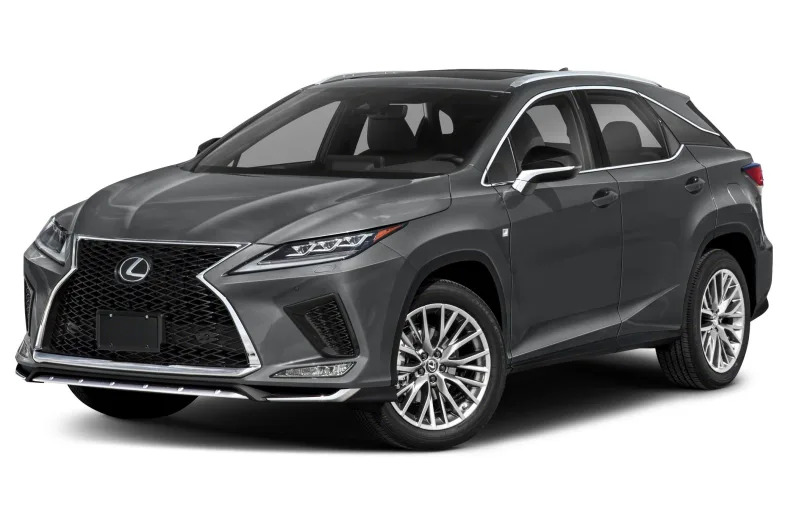F SPORT Performance 4dr Front-Wheel Drive
2020 Lexus RX 350
This post has been updated from its original version to reflect new information provided by Lexus engineers. There's something seemingly funky going on with the Lexus RX spec sheet, or at least with the cargo capacity measuring method used to populate it with an official cubic-foot number. Basically, the specs say it has 16.0 cubic feet behind its raised back seat. That would be less than a Toyota C-HR, which is a notably cramped subcompact SUV. All you need are eyes to know something's fishy about that. Doing these luggage tests has revealed other car companies also report cargo capacity figures that sell their SUVs short relative competitors, but this is a new low, so to speak. After a few back-and-forths with Lexus (and several months), plus a revealing glance at the extended length RX L's spec sheet, I came upon the answer: the 16.0 cubic-feet indicated is a measurement of the cargo floor to the cargo cover. The industry norm is cargo floor to the roof. Both numbers are provided for the RX L: 15.26 cubic-feet to the cargo cover and 23.03 to the roof. That's still not a lot for a midsize SUV, but assuming the regular RX is in the same numerical ballpark, it would make a lot more sense given how much stuff you can actually fit inside. Speaking of which, let's see just how much stuff you can fit inside. It's definitely more than a C-HR. This is a wide, deep space. However, the current RX has a more radically raked roofline than its predecessors, which almost achieves a crossover coupe look. The result is less overall cargo space (and likely a less-than-stellar floor-to-ceiling cargo spec), but losing greenhouse usually effects versatility more. Basically, you can carry a comparable number of bags, but that 52-inch TV will be a tough get. To begin, I left the cargo cover in place. As in every luggage test I do, I use two midsize roller suitcases that would need to be checked in at the airport (26 inches long, 16 wide, 11 deep), two roll-aboard suitcases that just barely fit in the overhead (24L x 15W x 10D), and one smaller roll-aboard that fits easily (23L x 15W x 10D). I also include my wife's fancy overnight bag just to spruce things up a bit (21L x 12W x 12D). Fitting only the four biggest bags isn't great, but it's also the result of keeping the cargo cover in place (I do this to replicate a situation where you can't just leave it behind in your garage). It also pretty much confirms that 16.0-cubic-foot number. That's comparable to a Hyundai Sonata's trunk and this looks awfully similar. OK, let's get rid of the cargo cover. There, all the bags fit. It was easier to load this in the RX than in the Acura RDX, which is the largest compact luxury SUV. It's extra width is a big part of that. However, the total number of bags and the …
Full Review
This post has been updated from its original version to reflect new information provided by Lexus engineers. There's something seemingly funky going on with the Lexus RX spec sheet, or at least with the cargo capacity measuring method used to populate it with an official cubic-foot number. Basically, the specs say it has 16.0 cubic feet behind its raised back seat. That would be less than a Toyota C-HR, which is a notably cramped subcompact SUV. All you need are eyes to know something's fishy about that. Doing these luggage tests has revealed other car companies also report cargo capacity figures that sell their SUVs short relative competitors, but this is a new low, so to speak. After a few back-and-forths with Lexus (and several months), plus a revealing glance at the extended length RX L's spec sheet, I came upon the answer: the 16.0 cubic-feet indicated is a measurement of the cargo floor to the cargo cover. The industry norm is cargo floor to the roof. Both numbers are provided for the RX L: 15.26 cubic-feet to the cargo cover and 23.03 to the roof. That's still not a lot for a midsize SUV, but assuming the regular RX is in the same numerical ballpark, it would make a lot more sense given how much stuff you can actually fit inside. Speaking of which, let's see just how much stuff you can fit inside. It's definitely more than a C-HR. This is a wide, deep space. However, the current RX has a more radically raked roofline than its predecessors, which almost achieves a crossover coupe look. The result is less overall cargo space (and likely a less-than-stellar floor-to-ceiling cargo spec), but losing greenhouse usually effects versatility more. Basically, you can carry a comparable number of bags, but that 52-inch TV will be a tough get. To begin, I left the cargo cover in place. As in every luggage test I do, I use two midsize roller suitcases that would need to be checked in at the airport (26 inches long, 16 wide, 11 deep), two roll-aboard suitcases that just barely fit in the overhead (24L x 15W x 10D), and one smaller roll-aboard that fits easily (23L x 15W x 10D). I also include my wife's fancy overnight bag just to spruce things up a bit (21L x 12W x 12D). Fitting only the four biggest bags isn't great, but it's also the result of keeping the cargo cover in place (I do this to replicate a situation where you can't just leave it behind in your garage). It also pretty much confirms that 16.0-cubic-foot number. That's comparable to a Hyundai Sonata's trunk and this looks awfully similar. OK, let's get rid of the cargo cover. There, all the bags fit. It was easier to load this in the RX than in the Acura RDX, which is the largest compact luxury SUV. It's extra width is a big part of that. However, the total number of bags and the …
Hide Full Review
Hide Full Review
Retail Price
$50,350
MSRP / Window Sticker Price
| Engine | 3.5L V-6 |
| MPG | 20 City / 27 Hwy |
| Seating | 5 Passengers |
| Transmission | 8-spd auto w/OD |
| Power | 295 @ 6300 rpm |
| Drivetrain | front-wheel |
Smart Buy Program is powered by 



